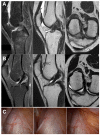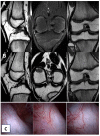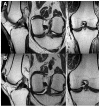Nanosurgical and Bioengineering Treatment of Human Anterior Cruciate Ligament Tears with Ultrasound-Guided Injection of Modified Platelet-Rich Plasma Using Human Cell Memory Based on Clinical, Ultrasound, MRI, and Nanoscope Analyses: A Double-Blind Randomized Trial
- PMID: 38731004
- PMCID: PMC11084372
- DOI: 10.3390/jcm13092475
Nanosurgical and Bioengineering Treatment of Human Anterior Cruciate Ligament Tears with Ultrasound-Guided Injection of Modified Platelet-Rich Plasma Using Human Cell Memory Based on Clinical, Ultrasound, MRI, and Nanoscope Analyses: A Double-Blind Randomized Trial
Abstract
Background: Anterior cruciate ligament (ACL) tears account for 40% to 50% of all ligamentous knee injuries. Most patients with ACL ruptures undergo surgical treatment. There is currently no objective, well-documented, repeatable, and standardized nonsurgical method for ACL tear treatment. This study aimed to investigate ACL outcomes in patients who underwent a novel nanosurgery and bioengineering treatment (NSBT) for an ACL tear. Methods: This was a double-blind randomized trial including 44 patients with a history of traumatic knee injury and a confirmed ACL tear. The final sample comprised 40 patients who met all the eligibility criteria. The patients were divided into two groups: the treatment group (n = 30) and the control group (n = 10). The treatment group underwent nanosurgery with an ultrasound-guided injection of modified platelet-rich plasma (PRP) using human cell memory (RP-hCM). The control group was treated with an ultrasound-guided PRP injection into the joint capsule. At baseline and post-treatment, all patients underwent both ultrasonography and magnetic resonance imaging (MRI), and the following clinical variables were assessed: the WOMAC score, the Lysholm knee score, the visual analog scale score, and knee instability. In most patients, the clinical outcome was verified using nanoscopy. Results: The median WOMAC, VAS, and LKS scores, as well as knee instability, improved significantly 12 weeks after the procedure in the treatment group (p < 0.001). We found a significantly larger improvement in the assessed parameters in the treatment group compared to the control group (p < 0.001). In the treatment group, all the patients had good and very good clinical outcomes, while 90% of the patients had a normal ACL signal in a follow-up MRI scan. In the control group, a physical examination revealed no changes in knee stability after treatment. Conclusions: This study showed that there is a significant difference in patient experience and the duration of recovery for patients with ACL tears treated with NSBT. The novel nonsurgical method was shown to be repeatable, objective, well documented, standardized, and highly effective.
Keywords: ACL; anterior cruciate ligament tears treatment; nanosurgery and bioengineering treatment.
Conflict of interest statement
The author declares no conflicts of interest.
Figures









Similar articles
-
Long-term Outcomes of Primary Repair of the Anterior Cruciate Ligament Combined With Biologic Healing Augmentation to Treat Incomplete Tears.Am J Sports Med. 2018 Dec;46(14):3368-3377. doi: 10.1177/0363546518805740. Epub 2018 Nov 6. Am J Sports Med. 2018. PMID: 30398894
-
Effect of platelet-rich plasma on healing of autologous graft after anterior cruciate ligament reconstruction: a randomized control trial.Regen Med. 2023 Aug;18(8):601-610. doi: 10.2217/rme-2023-0108. Epub 2023 Jul 25. Regen Med. 2023. PMID: 37491949 Clinical Trial.
-
Promising functional outcomes following anterior cruciate ligament repair with suture augmentation.Knee Surg Sports Traumatol Arthrosc. 2023 Jul;31(7):2836-2843. doi: 10.1007/s00167-022-07236-4. Epub 2022 Nov 29. Knee Surg Sports Traumatol Arthrosc. 2023. PMID: 36445405
-
Knee Ligament Sprains: Diagnosing Anterior Cruciate Ligament Injuries by Patient Interview. Development and Evaluation of the Anterior Cruciate Ligament Injury Score (ACLIS).Orthop Traumatol Surg Res. 2022 May;108(3):103257. doi: 10.1016/j.otsr.2022.103257. Epub 2022 Feb 24. Orthop Traumatol Surg Res. 2022. PMID: 35219887 Review.
-
Early Operative Versus Delayed or Nonoperative Treatment of Anterior Cruciate Ligament Injuries in Pediatric Patients.J Athl Train. 2016 May;51(5):425-7. doi: 10.4085/1062-6050.51.5.11. Epub 2016 May 31. J Athl Train. 2016. PMID: 27244126 Free PMC article. Review.
References
LinkOut - more resources
Full Text Sources
Research Materials
Miscellaneous

